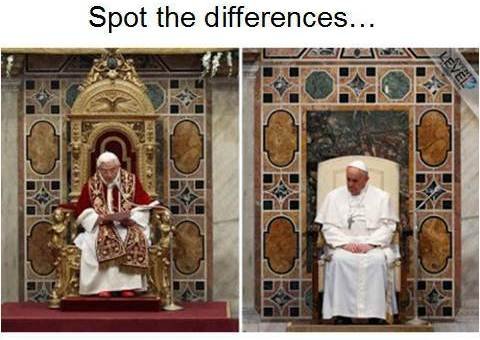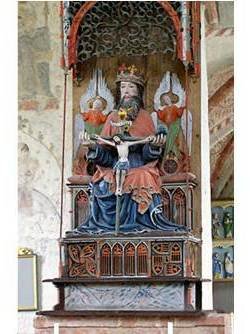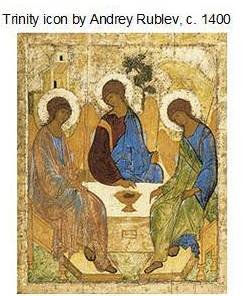|
Hierarchy and Holiness
by Major Harold Hill
Remember those cartoons where you are invited to
Spot the Difference?
Here’s one.

We hear of Pope Francis deserting the luxurious Papal
apartments to hang out in a sort of boarding house for
priests, scooting round Rome in a little old Ford Fiesta
instead of using an armour-plated Mercedes, laying aside
ornate vestments and handmade red shoes in favour of a simple
cassock and his old scuffs. He’s sending signals.
We’re used
to receiving and
interpreting such signals. I remember in my callow youth
asking the formidable Commissioner Robert A. Hoggard whether
he didn’t think his snazzy new 1952 Plymouth Cranbrook was a
little too flash for the Salvation Army to be seen going about
it? (I do not know where I got
that idea from!)

He replied, “Oh, no, not at all. Where I come from [USA
Western territory], this is a Lieutenant’s car. Commissioners
drive Cadillacs!”


Then when I went to London in 1970 I noticed that whereas a
mere Commissioner drove an Austin 1100, the Chief of the Staff
drove an Austin 1800, and the General was driven about in an
Austin 3 litre.

Years later in the USA Salvation Army National Archives I read
the correspondence between a Territorial
Commander and a
Lieutenant who was threatened with dismissal and was
eventually sacked because he wouldn’t dispose of his
Oldsmobile (I think it was), deemed
not to be a
“Lieutenant’s car”. I kid you not.
(Perhaps there was
another back-story.)
They were all signals. What these examples signalled was
“hierarchy”. The difficulty I found lay in reconciling those
signals with Jesus’ words, “That is the way the VIPs and
Celebrities of this earth go
on… Don’t be
like that!”[1]
All this may be juvenile taking of the mickey, but what was
signalled was no light matter. My subject, for which I am
indebted to Caroline, is
Hierarchy and
Holiness. I need to
talk about each in turn, and then about both together.
Hierarchy
Firstly, we’re familiar with the concept of
Hierarchy. A
pyramid, with the broad base of plebs at the bottom, rises
through more restricted levels of middle-management, to the
solitary splendour of the occupant of the apex. In his study
of Milton’s Paradise
Lost, C.S. Lewis explains how pre-modern society was quite
unambiguously and unapologetically structured hierarchically.
It wasn’t considered just a convenient and effective way of
constructing work relationships; it was seen as inherent in
nature. Lewis wrote,
Degrees of value are objectively present in the universe.
Everything except God has some natural superior. The goodness,
happiness and dignity of every being consists in obeying its
natural superior and ruling its natural inferiors… Aristotle
tells us that to rule and to be ruled are things according to
nature. The soul is the natural ruler of the body, the male of
the female, reason of passion. Slavery is justified because
some men are to other men as souls are to bodies (Politics,
1, 5).[2]
Now I’m not about to argue the anarchist or Leveller converse,
that Jack’s as good as his master, but need to remind you that
our whole clerical system in the church derives from this
hierarchical
conception of
reality, which we no longer take for granted today.
The early church was relatively egalitarian. It had leaders
but no priests. Over its first few centuries, as it
institutionalised, it accommodated to traditional religious
expectations, to hierarchical society and to the Roman state.[3]
The Church took on characteristics incompatible with its
founding vision of free and equal citizens in the Kingdom of
Heaven (rather like Israel’s earlier ideal of being a nation
of kings and priests).[4]
When society becomes too unequal and is at risk of breaking
down, Christianity seems to rediscover its roots and new
groups with a greater emphasis on internal equality are
formed.[5]
Thus renewal in the Church often coincides with disruption in
society as whole, or dissatisfaction of marginalised groups.
Both the Christian Mission and the 614 movement started in the
slums. Further, nearly all sectarian movements including and
from the early church on – monasticism, the mendicant orders
of friars, the Waldensians, the reformation churches and
sects, the Methodists and the Pentecostals, have begun as
“lay” movements, acknowledging little distinction of status
between leaders and led, but nearly all have ended up
controlled by priestly hierarchies, whether so called or not.
The more institutionalised the body becomes, the greater
degree of clericalisation and “hierarchisation” likely.
Bryan Wilson sums up:
What does appear is that the dissenting movements of
Protestantism, which were lay movements, or movements which
gave greater place to laymen than the traditional churches had
ever conceded, pass, over the course of time, under the
control of full-time religious specialists… Over time,
movements which rebel against religious specialization,
against clerical privilege and control, gradually come again
under the control of a clerical class… Professionalism is a
part of the wider social process of secular society, and so
even in anti-clerical movements professionals re-emerge. Their
real power, when they do re-emerge, however, is in their
administrative control and the fact of their full-time
involvement, and not in their liturgical functions, although
these will be regarded as the activity for which their
authority is legitimated.[6]
Religious authorities usually claim some “spiritual”
legitimation for their human behaviour. For example, in the
church there grew up a tradition that ordination indelibly and
irreversibly changes a person’s essential, ontological
character, just as baptism (or conversion, in the Evangelical
tradition) is believed to do. The second Vatican council stood
in a tradition stretching back to Augustine of Hippo (who died
almost 400 years after Jesus) when it asserted that
The common priesthood of the faithful and the ministerial
priesthood… differ essentially and not only in degree.[7]
Others deny that. Emil Brunner says that
All minister, and nowhere is to be perceived a separation or
even merely a distinction between those who do and those who
do not minister… There exists in the Ecclesia a universal duty
and right of service, a universal readiness to serve and at
the same time the greatest possible differentiation of
functions.[8]
Nevertheless, whether we hold that clergy are essentially
different from lesser mortals or we claim to believe in
equality, the end result is often the same. Miroslav Volf
noted that even in the contemporary unstructured house church
movement:
“A strongly hierarchical, informal system of paternal
relations often develops between the congregation and the
charismatic delegates from the ascended Christ.”[9]
Whether in the Exclusive Brethren or the “Shepherding”
movement, you know who is the boss. Having clerics does not
necessarily involve clericalism. Not having clerics does not
necessarily mean clericalism can be avoided. Office itself,
formal or informal, inevitably confers power and power offers
at least possibility of those who exercise it “tyrannising
over those allotted to [their] care”.[10]
(Peter was aware of the danger!)
In Walter Brueggemann’s
Prophetic Imagination, the alternative, prophetic
community of Moses is contrasted with the “royal
consciousness” of Egyptian Empire. Within 250 years of the
Exodus from Egypt, the establishment of Solomon’s Empire
represented the rejection of that free association of
Israelites and a return to structures of oppression.[11]
In the same way, the process of institutionalisation and
clericalisation in the church can be seen as a successful
reconquest of the new community by the old structures of
domination and power. These in turn may be subverted in due
course by renewed egalitarianism.
My argument is that the Salvation Army’s own development
conforms to this general pattern. I won’t rehearse tonight the
steps by which this came about – you can read my book if you
want the details; Salvationist Supplies still has some copies![12]
I’ll say just one thing: The Salvation Army doesn’t accept
that becoming a priest or a bishop (or, officer or an officer
holding “conferred-rank”) alters your Christian “character”,
but in practice it behaves as if it did. The most recent
expression of the Army’s clericalisation is found in the
adoption of “ordination” by General Arnold Brown in 1978.
Ordination came about originally because of the Church’s
adoption of the concept of “ordo”, the class structure of the
Roman Empire. The Army doesn’t endorse that, so why play dress
ups?
This is not saying we need no structure. Any human society
needs some form of order to avoid falling into either anarchy
or tyranny. A society called into being around some founding
vision requires some means of maintaining what in the church
is called “apostolicity” – authenticity derived from
faithfulness to a founding vision. That is part of the role of
leadership, which a hierarchy can provide. The danger with
leadership, however, is that rather than being merely a means
of maintaining authenticity, it can come to identify itself as
central to it, the means becoming the end. That is
clericalisation. That is the shadow side of hierarchy.
Holiness
Now, leaving Hierarchy for the present, what about
Holiness?
When I was growing up it was never explicitly stated but
somehow assumed quite widely that holiness was a matter of
personal morality, spirituality, piety and general “niceness”.
It tended to be regarded as a field for the
spiritually
athletic, the virtuosi, rather than the general
run-of-the-mill Christian like me. It was an advanced degree,
an honours course, to which a few went on after getting their
BA, or Born Again. Wesleyan Holiness, our traditional take on
the subject, has lost credibility over the years, partly
through being inadequately taught. The result, to adapt G.K.
Chesterton, was that rather than being tried and found too
hard, it was thought too hard and not tried. Put to one side
the tedious “shibboleth-sibboleth” debate about “crisis”
and/or “process” aspect of Holiness – I’m not concerned with
that!
Holiness has suffered, amongst other things, from an
unbalanced, individualistic interpretation of the gospel.
In our
Evangelical tradition Salvation, which includes holiness, was
about me, getting
me saved and
sanctified and going to heaven. When we read that holiness is
“the revealing of Christ’s own character in the life of the
believer”,[13]
that’s true, but it’s not the whole truth. That’s still about
me. In western
countries, that individualistic focus of our mindset was
intensified in the later twentieth century under the influence
of New Right economics when our whole society took a turn away
from social responsibility and towards the sanctification of
individual greed as the driving force of society, with the
excuse that by a process of trickle-down, all boats would rise
on the flood-tide of prosperity. That hasn’t just changed our
economic arrangements; it has increasingly permeated our
world-view. It didn’t alter our doctrine of holiness; it
merely completed the total skewing of our perception of what
holiness involved. That is, that it was just a matter for the
individual.
We glibly dismiss the people of Jesus’ day as preoccupied with
his setting up an earthly Kingdom, whereas his
Kingdom was “not
of this world”. We, with the benefit of hindsight, know so
much better than they did what he was on about.
Yes? No, not entirely.
If we read Jesus without our inherited spectacles of
individualism, we notice that a
lot of what he
talked about was not
about the saving and sanctifying of the individual as an end
in itself but about redeeming society as a whole. He came
preaching and teaching about the Kingdom of Heaven, which
wasn’t pie in the sky for me when I die, but the
redemption of
this
world so that it
would more closely resemble how God intended it to be. “Your
Kingdom come, your will be done, on earth as in heaven,” is
what he taught us to pray. A renewed emphasis on social
justice is a rediscovery of this dimension of holiness;
embraced by many, while many others regard it as a distraction
from the real spiritual business of saving souls.
Salvation, of which holiness
is a subset,
part of a continuum, is about
Shalom: wholeness,
peace, well-being, and
righteousness – which did not mean being goody-goody
two-shoes, but meant being in a
right relationship
with ourselves, with others and with God. Which is why John
Wesley exclaimed, against the notion of the solitary seeking
of perfection, that, “there is no holiness but
social holiness.”
Christianity is a team sport, not a narcissistic individual
hobby like body-building.
At the personal and interpersonal level, holiness is expressed
in what William Temple described as the “true test of
worship”: “not whether it makes us feel better or more holy or
more at peace… [but]
what it does to our lives; whether it makes us more unselfish,
more easy to live with, more efficient in our work.” That is
“becoming more like Jesus”. At the macro-level, a concern for
social justice is integral to a concern for personal holiness;
it is making the earth more like heaven. I cannot be holy and
still content that others suffer injustice. At Finney’s
campaign meetings 150 years ago, seekers were directed from
the “Mourners’ Bench”, either to the table at which they could
sign up to the anti-slavery campaign, or to the table at which
they could sign up to work for female emancipation and women’s
rights. And if they were unwilling to do either, they were
sent back to their seats: it was not believed that they’d made
a real decision to follow Christ.
So the polarisation we frequently encounter, between “saving
souls” and “serving suffering humanity”, as though either one
of these were more central, a loftier aim, and the other
merely optional window-dressing, is a false dichotomy.
As William Booth put it, there needs to be “Salvation
for Both Worlds”.[14]
Birds do not fly far on one wing only. If we want biblical
underpinnings of this argument we need look no further than
Jesus’ summary of the great commandments – to love God, and to
love our neighbour as ourselves.[15]
He said the second was “like the first”; it wasn’t a minor,
optional extra.
Hierarchy and
Holiness?
Hierarchy is a way of structuring relationships; holiness is
to do with the nature of those relationships.
One is to do
with form; the other is to do with essence. So the question
needs to be asked, how holiness may be expressed in socially
just relationships. Can our institutional structure, our
hierarchy, facilitate loving behaviour, by all involved, so
that we love all our associates, both those in authority over
us and those subordinate to us, as we love ourselves? This is
at the heart of the question of what holiness has to do with
hierarchy.
I suggest that
that the hierarchy created by clericalisation is a form which
can make its imprint on the essence instead of the essence
being expressed in the form. That’s a very sweeping
generalisation and therefore only partly true, but let’s tease
out the tension between hierarchy and holiness.
Firstly, the hierarchical structure which clericalism has
created can foster a spirit incompatible with “servanthood”
Jesus modelled and taught; it can undermine relational
holiness and so threaten the kind of community Jesus calls
together.
Secondly, by concentrating power and influence in the hands of
minority, clericalisation can disempower the majority of
members of Church. That can co-exist with patronising the
brethren but not with loving the brethren. It can therefore
diminish the Church’s effectiveness in mission.
Of the first adverse
effect, you could supply your own examples, but if it’s any
help, Bramwell Booth was aware of the danger long back.
In 1894 he was complaining that “the D.O.’s [Divisional
Officers] are often much more separate from their F.O.’s
[Field Officers] than they ought to be. Class and caste grows
with the growth of the military idea. Needs watching.”[16]
Thirty years later he was still anxious about Divisional and
Territorial leaders in that “they are open to special dangers
in that they rise and grow powerful and sink into a kind of
opulence…”[17]
(Unhappily, Captains are just as prone to this as Colonels.)
General Albert Orsborn acknowledged to the 1949 Commissioners’
Conference that
dissatisfaction and decline… is blamed on our system of ranks,
promotions, positions and differing salaries and retirements…
that it has created envy and kindred evils and developed
sycophancy, ingratiation, “wire-pulling”, favouritism, etc… It
is a sad reflection that we are in character, in spirituality,
unable to meet the strain of our own system.[18]
Koinonia
and just social relationships are difficult to maintain within
that system. All of which is to say that it is in the nature
of systems to get in the way of the reason they exist.
If the doctrine of holiness is not lived as well as
talked about, human nature will take its course, and a system
which
actually encourages it to do so, as
ours tends to, requires extra vigilance.
And the second adverse effect, the disempowerment of the many
by the exaltation of the few?
The American Nazarene sociologist Kenneth E. Crow summed it
up: “Loyalty declines when ability to influence decision and
policies declines. When institutionalization results in
top-down management, one of the consequences is member apathy
and withdrawal.”[19]
Likewise the Indian Jesuit Kurien Kunnumpuram claimed that
“the clergy-laity divide and the consequent lack of
power-sharing in the Church are largely responsible for the
apathy and inertia that one notices in the bulk of the laity
today.”[20]
Does our structure likewise disempower the Army’s
soldiery? The root of disempowerment is a lack of respect for
others, and that is, again, evidence of a failure to love
one’s neighbour as oneself.
It would be difficult to say whether clericalisation had led
to a loss of zeal, or loss of zeal had been compensated for by
a growing preoccupation with status, or whether each process
fed the other. There is a paradox here: the military system,
quite apart from the fact that it fitted Booth’s autocratic
temperament, was designed for rapid response, and is still
officially justified in those terms. The Army’s first period
of rapid growth followed its introduction. It caught the
imagination for a time. However the burgeoning of hierarchical
and bureaucratic attitudes came to exert a counter-influence.
The reason for success contained the seeds of failure. The
longer-term effect of autocracy was to lose the loyalty of
many of those hitherto enthusiastic, and to deter subsequent
generations, more habituated to free thought and democracy,
from joining.
Clearly I’m talking about what we may loosely call the
“Western” Army. In Africa and India the Army is still
expanding rapidly and
is also extremely rank-conscious! The cultures are different.
I do not believe that in
our culture, our
salvation lies in the hair of the dog that bit us.
Furthermore, the abuses of power already evident in the third
world Army suggest that there will be a reckoning to pay there
too. Faced with a flagrant example of such abuse in the past
year, a Zimbabwean Salvationist wrote, “The
Salvation Army now frightens me… We now know we are waging war
against a Monster… Our very own church! Am now very ashamed to
wear my uniform and so are many other people.”[21]
Such a reaction does not augur well for continued expansion.
Unfortunately clericalism is to clergy as water to fish,
wherever we live. It’s so pervasive we don’t recognise it, but
as a soldier working at THQ once said to me, “It’s in our
faces all the time!”
How may the ill-effects of the hierarchical system be
mitigated? That
is, how may the essential holiness still be
expressed through this form?
Leadership is indispensable to the effectiveness of any
movement; it’s a given. Structure is necessary; it will happen
anyway, and it needs continuity, accountability and legitimacy
to mitigate the effects of unrestrained personal power.
There are two ways the problem can be approached: one is
structural, the other attitudinal.
In 2002 the first edition of the Salvation Army’s Doctrine
Council’s publication,
Servants Together, made the following suggestions for
structural change:
What actions does Army administration need to take in order to
facilitate servant leadership? Here are some of the important
ones:
·
Develop non-career-oriented leadership models.
·
Dismantle as many forms of officer elitism as possible.
·
Continue to find ways to expand participatory decision-making.[22]
I believe structural change is essential but none of us is in
a position to make it, and you know it’s not going to happen.
In fact that whole paragraph quoted was deleted from the
second, 2008, edition of
Servants Together.
And wherever else the expression “participatory
decision-making” was used, that was replaced by “consultative
decision-making”.[23]
Do you draw any conclusions from those excisions? Perhaps none
of the structural changes suggested might have made any
difference anyway.
In 1996 when Commissioner (later General) John Larsson was
about to conclude his term as Territorial Commander in New
Zealand, he kindly invited me to arrange the annual Executive
Officers’ Councils as a training seminar. With his approval I
engaged Gerard La Rooy, a Heinz-Watties executive and
management guru, to lead sessions on “Flatter Structures” in
management. By citing awful examples from the realm of
business and expressing astonishment at the laughter as the
officers recognised the same scenarios as found in the
Salvation Army, he led them to consider how the work might be
enhanced by flattening out some operations of the hierarchy.
Some “participative decision-making” might have been involved.
They got as far as drawing up suggestions for change – all
pretty minor but likely to improve efficiency – and nominated
a working party to continue developing the theme in the coming
weeks. Then it all went quiet. After some weeks I asked the
Chief Secretary, Hillmon Buckingham, “What happened?” “Ah,” he
replied, “For the week after the Councils I had a succession
of senior officers come to my office saying, ‘We might have
got a bit carried away with this flatter structures business…
I think we should be a bit careful…’” And so we were. Even the
slightest tinkering with the structure of hierarchies can
produce severe symptoms of insecurity.
And the truth is that no structure can ensure that we love our
neighbour – whether our senior in the command structure or our
subordinate – as ourselves. That leaves our
attitudes. The 2002
text of Servants
Together made one other suggestion:
·
Teach leaders to be servants by modelling it.[24]
That was also deleted from the 2008 edition.
I guess it was too much like Jesus, or Paul… in a word,
subversive. Too often, the mantra “Servant Leadership” is an
oxymoron. Servant is as servant does. To model
servanthood is the only suggestion most of us can aspire to
implement, but it is also the most important. And where
opportunity affords, to name and challenge its antithesis, its
shadow, which is the abuse of power.
Because power is at
the heart of the matter. Money, sex and power are said to be
the three pitfalls for clergy, but the first two are usually
only means to, or expression of, the third. Hans Rudi Weber
wrote that “Jesus transforms the love of power into the power
of love.”[25]
Sometimes we get it the wrong way round.
Power, like steroids taken by an athlete, may enhance
performance but exact a long-term cost.
So the question is whether holiness, both personal holiness
(which is being like Jesus) and corporate holiness (which is
the application of the principles of social justice to our
structural relationships, so that the Body of Christ can be
like Jesus), can redeem a hierarchical institution?
 Over
the years the doctrine of the Trinity has been presented in
such a way as to support a hierarchical conception of both God
and the Church. Here is a medieval Swedish Gothic
representation of the Trinity. You can see who is in charge. Over
the years the doctrine of the Trinity has been presented in
such a way as to support a hierarchical conception of both God
and the Church. Here is a medieval Swedish Gothic
representation of the Trinity. You can see who is in charge.
But there is another tradition, of what is termed the
perichoretic trinity. Here is an ancient icon. Who is in
charge here?

So, is there a way in which Hierarchy may be Holy? If so, the
Hierarchy may not look like we expect. Paradox is involved.
Colonel Janet Munn, being interviewed last month, spoke of the
paradox in Jesus’ combination of humility and boldness (by
contrast with the frequently found human combination of
arrogance and cowardice). She noted that “Servanthood requires
humility; leadership demands boldness.”[26]
Jesus in fact deconstructed leadership along these lines: “I
do not call you servants any longer, because a servant does
not know what his master is doing.
Instead, I call you friends...”[27]
Mind-blowing it may be, but he is inviting us to gather round
that table. The implications for both hierarchy and holiness
are worth considering.
[2]
C. S. Lewis, A
Preface to Paradise Lost (London: Oxford University Press, [1942]
1960) 72-3.
[3]
A comprehensive account of the process is found in
Colin Bulley,
The Priesthood of Some Believers: Developments from
the General to the Special Priesthood in Christian
Literature in the First Three Centuries (Carlisle:
Paternoster, 2000).
[4]
Exodus 19.6; Revelation 1:6; 5:10.
[5]
The egalitarian vision remained, in David
Martin’s terms, “a store of explosive materials
capable of fissionable contact with social
fragmentation” so that “schism is inevitable and
rooted in the nature of Christianity itself as well as
in the nature of society.”
David Martin,
Reflections on Sociology and Theology (Oxford:
Clarendon Press, 1997) 42-3.
[6]
Bryan Wilson,
Religion in Secular Society (London: C.A. Watts,
1966) 136.
[7]
“Dogmatic Constitution of the Church, Article 10” in
Austin Flannery (Ed.)
Vatican Council
II: The Conciliar and Post-Conciliar Documents
(Collegeville Min: Liturgical Press, 1975) 361.
[8]
Emil Brunner,
The Misunderstanding of the Church (London:
Lutterworth, 1953) 50.
[9]
Miroslav Volf,
After Our Likeness: The Church in the Image of the
Trinity (Grand Rapids: Eerdmans 1998) 237.
[11]
Walter Brueggemann,
The Prophetic
Imagination (Minneapolis:
Fortress Press, 2nd edn 2001) 23.
[12]
Harold Hill,
Leadership in the Salvation Army: a case study in
clericalisation (Milton
Keynes: Paternoster, 2006).
[13]
Frederick Coutts,
The Splendour
of Holiness (London: Salvation Army, 1983) 41.
[14]
William Booth, “Salvation for Both Worlds”,
All the World,
5 (January 1889) 1-6, reprinted in Andrew M. Eason and
Roger J. Green (Editors),
Boundless
Salvation: the shorter writings of William Booth (New York: Peter Lang, 2012) 51-9.
[16]
W. Bramwell Booth, letter of October 1894, in
Catherine Bramwell Booth,
Bramwell Booth
(London: Rich & Cowan, 1932) 218.
[17]
W. Bramwell Booth, letter to his wife, 27 April 1924,
in Catherine Bramwell Booth,
Bramwell Booth,
437.
[18]
General Eric Wickberg, “Movements for Reform” (Address
at the 1971 International Conference of Leaders)
Minutes, 9.
[21]
Email in my possession.
[22]
Servants Together
(2002), 121.
[23]
A letter to Territorial and Command leaders from the
Chief of the Staff, dated 31 July 2008, stated, “…it
is the General’s wish that all copies of the previous
edition be removed from trade department shelves,
training college libraries and any other resource
centres where copies may reside, and destroyed. Also,
in publicizing the revised edition within your
territory/command, please encourage your officers and
soldiers to purchase this latest
edition and to
discard any copies they may have of the 2002 edition.”
Upon being asked about this, Commissioner Dunster
wrote further that “The General’s request for copies
of the first edition to be discarded is simply a
matter of practicality and good sense. We do not
really want classes of cadets - or others - where some
are using the old book and others the new one. That
would lead to unnecessary confusion.”
Letter to Major Kingsley Sampson, dated 19 August
2008.
[24]
Servants Together
(2002), 121.
[25]
Hans-Ruedi Weber,
Power, Focus
for a Biblical Theology (Geneva: World Council of
Churches, 1989) 167.
|